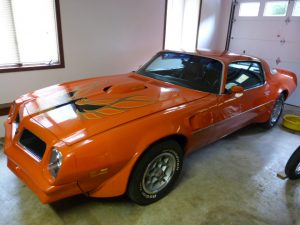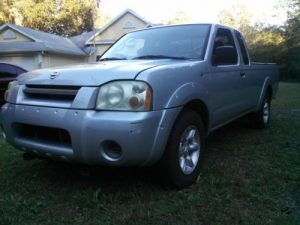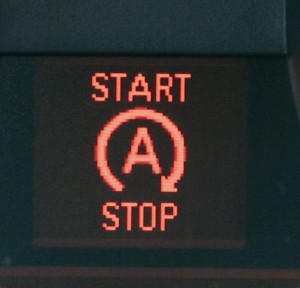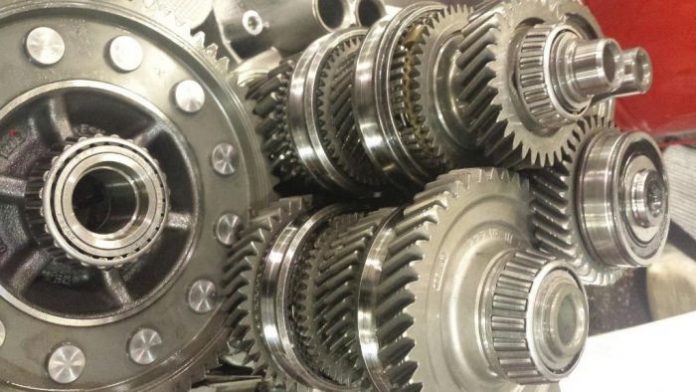Weight – and gearing – have a yuge effect on fuel economy. Even to the extent of almost eliminating 40 years of “advanced” technology, including computer-controlled electronic fuel injection. To make the case, I offer the following comparison:
I own one relatively modern vehicle – a 2002 Nissan Frontier pickup – and one extremely not-modern vehicle – my infamous 1976 Pontiac Trans-Am, aka the Orange Barchetta (or Great Pumpkin).
These two are very different – and very similar.
One is a truck and has a fuel-injected, computer-controlled four cylinder engine. The other is muscle car with a huge V8, fed by a carburetor controlled by my right foot.
The V8 in the TA displaces 455 cubic inches, which amounts to 7.5 liters in today’s anodyne, metrosexualized metric-speak (how that took over is fodder for a future rant).
The Nissan’s four is a mere 2.4 liters, less than one-third the displacement.
Yet both vehicles get about the same gas mileage.
Part of the reason for the Nissan’s dismal mileage – 20 city, 23 highway, according to the EPA and less according to me, its owner, who has direct real-world experience of its actual mileage – is because the thing is heavy (about 3,300 lbs.) and underpowered (just 143 hp to pull all that around).
Plus one other reason, which we’ll get to presently.
The TA is even heavier – about 3,700 lbs. – and that big V8 makes more than twice the horsepower.
Despite that, it hardly uses more gas – and sometimes, less. On the highway, the TA has achieved the EPA’s best-case advertised mileage for the Nissan (23 MPG) which in real-world actual driving is more like 18 or 19.
This disparity puzzled me . . . until I noticed the tach.
The Nissan’s cruise RPM – how fast the engine is spinning – is higher than the TA’s cruise RPM at greater road speed. At 60 or so MPH, the little truck’s four is buzzing along at about 2,500 RPM while the TA’s engine, at 70, is burbling along at barely 2,000 RPM – not much more than a fast idle.
The TA can achieve 75-80 without the RPMs rising much higher, too.
Then I remembered some other things – and looked up a few more.
About ten years ago, I replaced the TA’s factory non-overdrive transmission with a transmission that did have overdrive gearing – a very deep .067 overdrive in top gear. This transmission counteracted the fuel-sucking effect of all those liters (or cubic inches) connected to comparatively aggressive 3.90 gears in the TA’s rear axle. Without the deep overdrive gearing in the transmission, those 3.90s would have the TA’s big V8 screaming at around 3,500 RPM at 65-70 MPH and using more gas than the Nissan’s worst-case actual mileage.
Which brings me to why the Nissan uses as much gas as it does – which is as much as a ’70s-era V8 muscle car – notwithstanding its smaller engine, lower curb weight and all the technological advantages of the preceding several decades:
It hasn’t got overdrive gearing as advantageous as the TA’s.
The truck has a five-speed manual transmission – and fifth gear is an overdrive gear. But the ratio is .81 – which isn’t as low (or as high, depending on how you prefer to put it) as the .67 overdrive ratio in the TA’s transmission.
It also has an even more gas-hungry (and RPM-escalating) 4.63 ring and pinion, probably necessary because there’s so little engine and not much power and when that’s the case, you badly need leverage to get 3,300 lbs. of truck moving decently.
Nissan could have gotten maybe 25 or better – actual/real-world mileage – out of my little truck by using a less aggressive ratio in the rear axle, something like a 3.08 or even a 2.73. This would have reduced engine RPM in top gear at cruising speeds considerably. It also would have made my already lethargic truck – zero to 60 in 11.4 seconds, slightly off the pace of a Prius givin’ her all she’s got, capn’ – practically cataleptic.
But a six-speed transmission, with a deep overdrive in sixth – would solve both problems. The truck would be quicker, probably (tighter gear spacing, more advantageous leverage) and – once up to speed – it would be more fuel-efficient.
I looked up the specs of the current (2019) Frontier, which is a bigger (mid-sized) and much heavier (4,200 lbs.) and enormously more powerful truck (261 hp from its optional 4.0 liter V6) and discovered that its EPA-rated mileage – 16 city, 23 highway – is practically dead heat with my truck’s mileage.
The highway numbers are in fact identical – 23 MPG for both.
The bigger/heavier (and bigger-engined) 2019 truck uses more gas getting going (16 city) but once it’s rolling, the .76 overdrive in its six-speed transmission makes up for a lot.
And makes a much bigger real-world difference than annoying gimmicks such as ASS – Automated Start/Stop and quite possibly things like cylinder deactivation and direct injection, too.
If an old muscle car like my TA – with one of the biggest and thirstiest V8s ever put into any car – can approximate the mileage delivered by a modern vehicle with a small, fuel-injected and computer-regulated engine just by adding deep overdrive gearing to the mix – imagine what could be done with a more reasonably engined vehicle.
Without even needing to add fuel injection or computers to the mix.
. . .
Got a question about cars – or anything else? Click on the “ask Eric” link and send ’em in!
If you like what you’ve found here please consider supporting EPautos.
We depend on you to keep the wheels turning!
Our donate button is here.
If you prefer not to use PayPal, our mailing address is:
EPautos
721 Hummingbird Lane SE
Copper Hill, VA 24079
PS: Get an EPautos magnet (pictured below) in return for a $20 or more one-time donation or a $5 or more monthly recurring donation. (Please be sure to tell us you want a sticker – and also, provide an address, so we know where to mail the thing!)
My latest eBook is also available for your favorite price – free! Click here. 












Last week I picked up a ’99 Frontier, 2.4L/5 speed manual/ ext. cab/2wd. This thing is a Scooty Puff Jr., all the power of an asthmatic leaf blower (I actually got dusted by a large box van yesterday), but has been returning 23+ mpg in town and I am anything but a hypermiler.
What changed between ’99 and ’02?
The article made me curious about my ’09 Nissan 370Z. 6th gear ratio (overdrive) is 0.79. Could be better. However, how it’s driven makes a difference too. It’s rated at 26mpg hwy. But in real-world long distance road trips (particularly I-80 coast-2-coast), I could coax it to 30, despite an average speed of 80mph, with occasional spurts to 100+, in states like Utah and Nevada.
Eric, I noticed a similar disparity between my 2007 Mustang GT and my current 2008 Mazda MX-5 Miata.
I didn’t research all the details, but the GT averaged 30 MPG for the years I owned it. Miata, a much smaller car, with a much smaller engine, is only able to churn out 29 MPG. So far, so good.
The problem? The Mazda only holds 13 gallons of fuel, compared to the 16 that would fit in the Mustang. So I have to refuel 100 miles sooner.
But the coup de grace: The Miata requires PREMIUM FUEL!
You guys are gonna love THIS new proposal by Virginia … “Virginia Considers Cameras To Issue Tickets On Alternate Routes Around I-81 Toll Road – http://thenewspaper.com/news/66/6635.asp
Another case of state approved “butt rape” try to send some money to your convict friends, then a sanctioned creature called “J Pay” extends its grisly paw.This country is being fed bit by bit to the “Robber Barons” and they are getting fat( you better get to “Galt Gulch” before its called a Federal Nature preserve or some kind of restricted nonsense where you can’t look at what the taxes are paying for)
Kevin, I sent money to my cousin in prison. He got the money, as in, the state held the money and the only way he could use it was to buy from the state.
I wrote a letter and wondered if he got it since I was a felon and sholdn’t have been on his list of “approved” communications. It wasn’t possible to call him, no surprise there and so my concern for him wasn’t going away, I wrote and said I’d send more money,just wanted to touch base with him.
He wrote me back and said to send no more money. Turns out the state got almost all of it and what he could buy was not only theft but almost useless since he didn’t smoke.
I worried a lot about him since he quite writing back. No telling what was up with that and when I talked to him when he was minorly free, he didn’t even want to go over what had happened. I was just glad he was breathing semi-free air and was semi-healthy.
This whole incarceration deal sucks,I can write and get a message through(J Pay) I think I can I can still receive letters from there,I think everything that is sent via E-mail is monitored( surprised they didn’t call my hand, sent a few that were not very nice about the system) I believe the cost of sending money to a Prisoners account is $4.95 per transaction now the system will no longer take money orders, the stuff on commisary is not first quality and over priced now the only tv they can have is a transparent 12″ flat screen cost over $200, makes you think the wrong ones are behind bars.
There is absolutely no privacy in the so called “Dorms” the low security
‘camps” have triple razor wire chain link fence a very restricted library( it hard to get a book) plenty of black mold and scabies.I think its time this whole suck ass system be revamped( I was basically looking at 25 years for letting my daughter have a marijuana bowl( she was already using that stuff wanted to taper Her off of it- they interferred I got sent to prison for my first offense in 50 some years and She ended up using hard stuff because I wasnt there to stop her( She about to get beat to death one night) I hate and positively despise our farce for a legal system.
I guess this is why we are seeing 6 and 9 speed transmissions.
Hi Johnny,
It is, exactly. These transmissions have two or more OD ratios, “stepped” to get the drivetrain up to a very deep final OD… in some of the new cars I’ve driven with these boxes, RPM at 65 is less than 2,000.
eric, my old Z 71 only turns about 1700 rpm at 65 and it’s only a single OD. I suspect the reason is so that every time you let off of it, it drops a gear or two and coasts better.
Hey Eric, just curious, but what kind of tranny are you running in the TA? Aftermarket or did you modify the existing turbo 400? I have a 72 Torino and a 70 Challenger, both with V8s.
The 1965 Corvette I once had (300 HP, 4 spd. manual) weighed about 3,000 pounds and turned 2650 RPM at 60 MPH. I had always wished I could shift into a higher gear. It generally didn’t get much more than 15 to 17 MPG overall. My 2008 Corvette (436 HP, 6 spd. manual) weighs about 3250 pounds and turns a mere 1300 RPM at 60 MPH. This is LESS THAN HALF of what the old Corvette turned at the same speed. Most of my driving is on country roads and some city driving where it averages 23 MPG. On long trips on mostly interstate highways it delivers 30 to 31 MPG at speeds above the posted limit. On one 79 mile (mostly interstate highway) trip I let the speed fall off as I climbed hills and then coasted downhill. 33+ MPG was the result. This isn’t having your cake and eating it too, but it’s close. Domestic car makers could do better than this if Uncle Sam would just step aside and stop forcing them to produce cars with designs and features we don’t want.
Amen, John!
And – I bet you wish you still had that ’65, eh?
I have a ’70 Mustang with 4.11’s and decided to switch from an automatic to a Tremec 5-speed with a .6 OD so I can enjoy taking it on longer-distance trips. Went from about 3500@70mph to about 2200rpm.
I also have an ’03 5-speed Focus and have wished I could change the gear from ~3.9. It gets around 31mpg in the summertime but I think should get much better. First gear seems much lower than necessary and OD not high enough. Runs about 3000 @ 70mph. I don’t understand why it was set up like that but suspect it was because the engineers made compromises due to idiotic gov’t regulations.
Years ago I ordered a 1990 Dodge Daytona ES with the Mitsubishi V-6 and 5spd Manual trans ( I still have the car) and on the highway at cruise of 65 MPH (remember that 55 mph was the norm) that car would regularly get 38 MPG on the long flats driving and 25 around town … STILL a pretty modern car considering it has airbags, ABS, 4 wheel discs etc …
Cars of today STILL have trouble boasting those numbers …
Hi Art!
Yup – in re the mileage of today’s cars – chiefly because they’re monstrously overweight. And most of that is due to the necessity of complying with government saaaaaaaaaaaaaaaaaaaaaaaaaaaaaaaaaaaaaaaaaaaaaaaaaaaaaafety mandates.
My family owned a Pontiac Dealership for decades. When grandpop died and the worst side of the family took over and ran it into the ground, I bought a 78 280Z Datsun. Awesome car on dry road. Pulled a 5 speed out of a different one, put it into my original 4 speed, didn’t change the gearing in the rear end, and accidentally ended up with a rocket car. The suspension in the back was built for traction, so coming off the line the tires would spin once, and the car would launch. 6 cylinder torque did the rest. I just wish they hadn’t made them out of recycled american steel, or it wouldn’t have rusted out from under me. Awesome ride with your butt 8 inches off the gound…
Never could figure out why the yank engineers could not figure out how to build an engine/gearbox combination and pair it with a final drive ratio that would deliver far better fuel economy than most did.
I’ve had Mercedes and Volvo cars from the mid-1960’s through to the early 70’s that got great mileage for heavy four door cars, and their engines turning quite high RPM. Mercedes 220 SE from about 1962, using the Bosch six piston mechanical fuel injection (same system as on the 300 SE Gullwing from the late 1950’s, the one that would cruise at 140 MPH for as long as you had road and guts to coniinue) would cruise at 80 to 85 mph for hours, and return 40+ mpg on cheap regular. Not bad for a heavy luxurious four door. And the venerable old VOlvos, with the pushrod B 18 or B 20 engine, would cruise at the same speed and return about the same fuel economy, 42 mpg at 85 all day long. That ehgine woiuld be turning at just under 4000 rpm, and they’d still run with that treatment for a few hundred thousand miles. Their engines never hesitated to wind like crazy. I knew of a guy fitted a B 20 marine engine to his boat, propped it for top speed, and that boat would fly across the water for as long as he’d let it, engine turning very close to 8000 rpm for hours. Fuel consuption was far less than the same boat with a GM V 8 on a four barrel, and that crazy little four from Volvo would produce enough power to keep up with the smallblock GM V 8. Made for a much lighter powerplant with a smaller footprint, too.
Don’t suppose you are gonna sell the TA anytime soon?… Beautiful car!
Hi Ken,
I hope I can keep the TA until it’s time to shed my container! That car has been with me longer than anything; it outlasted my marriage – and every four-pawed friend so far.
It’s the one constant in my life…
Eric wrote:
“The V8 in the TA displaces 455 cubic inches, which amounts to 7.5 liters in today’s anodyne, metrosexualized metric-speak (how that took over is fodder for a future rant).”
I’ll look forward to that, as that is something I rant about all the time.
Even after forty years, I’m still flummoxed…tell me you got 5.7 liter whatever and I’m “huh”.
Tell me you got a 350 block and it all makes sense.
When you write your rant be sure to include the history of the murderous Jacobins in revolutionary France (whose modern day equivalents are sharpening up the guillotines for people like all of us as we speak) and how they insisted,by force, that everybody adopt metric measures, including metric time, so as to do away with the “old order”.
An anecdote I’ve told before, but as I descend into old farthood I claim the privilege of repeating myself. As a teenager I had an old Rambler 660 (it was old, even back then) with a V8 and column stick shift. It also had an electrically operated overdrive (activated by a switch on the dash) which was entirely unreliable but when it worked gave me around 22 mpg at 75 mph on the highway. Needless to say, the car was unaerodynamic but still frugal with gas, and had decent power.
I’ve always wondered why Rambler and other car makers didn’t simply add another gear as an overdrive. Our family had a couple of Yamaha XS11s, a big rocketship in its day. Yet their cruising rpms were ridiculously high for such big engines and their shaft drives made gearing changes impractical. A 6th gear would have been easy and cheap to add at the factory, but they didn’t bother.
Hi Ross,
Same issue with my ’83 Honda GL650 – which I otherwise love. It has five speeds and I think fifth is 1:1 … at any rate, the thing screams at 4,500 RPM at 60-ish. Granted, it has a 9,000 RPM redline, but still. One more gear (an OD gear) would have made this bike so much more highway enjoyable and probably kicked the already very good mileage (60-ish) closer to 70 on the road.
Fifth on the GL is probably around .8. (A Clymer manual for the bike would probably confirm what the ratio is. Fourth is usually 1:1). But .8 usually doesn’t feel like enough overdrive gearing. I have a Honda PC 800 with a .8 fifth gear and I’m always instinctively wanting to upshift when I’m in fifth.
Overdrive gears need to be in the .7 to .75 range…
Thanks, X!
I have my shop manual in the garage somewhere… and you’re right, fifth feels “not OD” even though it prolly is. Love the bike otherwise, though.
Would it pull taller gears?
The reason it wasn’t done is primarily money. The independents like AMC and Studebaker in particular had miniscule engineering budgets and did not make their own transmissions, they bought what was available off the shelf. Even at Mighty GM three-speed manual and two-speed automatic transmissions were king back in the 1950s-1960s. They might have had the resources to do more but gas was cheap, the car-buying public was not demanding it and neither was Uncle, so why spend the money? It was easier and cheaper to simply add an overdrive unit to an existing transmission for people who wanted extra economy of operation.
Then there was the issue of familiarity for drivers of the time, primarily the World War 2 generation. The prevailing attitude of the manufacturers was that the average driver would scoff at anything other than a 3-speed manual transmission and didn’t care how many cogs an automatic came with. (Four on the floor was for hot-rodders.) In fact if you remember the tiny Nash Metropolitan, which was a captive import built in England, Nash had 1st gear on the normally 4-speed Austin transmission blocked off specifically because they believed their customers would be scared off by anything more than 3 gears.
so the REAL trick with those gooofy old Metropoliltans was to have done with the jury rigged “three” speed gearbox and drop in a four speed from a Morris Minor, MG Micgetn, or Austin Healey Sprite. then flip a ring and pinion set in there that gave about the same final drive ratio in first as the “three” speed rendered, but that now-huge top cog would slow the engine way down. That puny 1500 cc (yes, the Brits used metric for displacement back then) BMC A block was also decammed, and sucked from a single downdraft Solex, I beleive, carburetter into a fairly low compression ratio chamber. In all, a gutless wonder.
Meanwhile MG, from whom most of the design and components of the Metropolitan derived) had been building the ZA and ZB four door saloon cars with essentially the same powertrain as the Metropolitan, except that MG left the pair of SU carburetters, raised the compression about a full point, slightly more open exhaust, and had a very fine road car with a classy well-appointed interior. While not as fast as the A and later B roadsters (final drive was lowered a touch because of the heavier car)those “Magnette” saloon cars were quite capable on the motorways. The ultimate version was the ZB Mk II from 1962 and 3, featuring the somewhat snappier 1622 cc version, mounting front disc brakes, and adding the very fine Laycock o=electric overdrive unit to the tailshaft of the same four speed box used in the roadsters. I owned/drove a few of the earlier Magnettes, but never could find a Mk II. Sometimes I thought I’d take a ZB with a very tired engine, then go find a 1967 MGB wreck, and do some presto changeo. I’d have arrived at the same thing. But then I happened across a Jaguar Mk VII saloon car, a bit scrappy in appearance, but still ALL Jaguar and ten times the fun. that big pig saloon still returned mid0twenties per gallon of petrol, would roll to 80 mph in third, and still jump when changed into top.
Smaller engines don’t necessarily get better mileage, especially if they don’t have enough power for the job. It’s got to run higher rpm just to get around.
You could probably get better mileage in your Nissan if you could drop in a small block Chevy v-8 !
But yeah, gearing! My jeep 4.0 gets about 10 mpg running around the back roads but 20+ out on the highway. Once you hit about 40 mph and the OD kicks in, the RPMs drop way down (about 2000 @ 65mph). I’ve got the “Power” switch on, though, because otherwise at 35 mph it just keeps jumping in and out of OD which is annoying and can’t be good for the AW4.
Hi Not left,
I have a better plan! I would like to put a politically incorrect VW TDI/six-speed into the thing. Can you imagine? The VW makes the same hp as the Nissan gas engine and about 100 ft.-lbs. more torque. In a Jetta, this driveline easily gives 50 MPG, so better than 30 in the truck ought to be realistic. Probably closer to 35.
Plus, it would annoy the SJWs!
Annoy them all the way back to Hanoi……..
Stick a 2.8 cummins in the thing if you can afford it, a small LS would light the tires and get decent mileage if you put on bigger rear tires and swapped the gearset to a 3.70, just putting in a small block without gearing change would be a horrible idea, it would probably be like driving those old stump puller jeeps with the GM V6 installed, you can remenber when the old Luxury boats would return 20 mpg with the mega motors and effortless cruise? Same thing applies here ( go find an Aluminum 4.3 or 4.8 LS to stick in that little bugger( spoiler- any LS engine is already an upgrade, check the numbers if not believed)
What matters is getting the engine RPMs optimized for the engine load. If you got such deep final drive gearing that the TA could theoretically go 70 MPH at, say, 800 RPM, you’d basically be wasting a gear or three because the engine would lug at that speed. That’s why automatic transmissions don’t just pop into 5th gear at 25 MPH.
My car, if driven with a light foot, will settle in at between 1500 and 2200 RPM at highway speeds up to 75 MPH or so. Hit a light hill, it’ll pop down a gear, because 1500 RPM and a heavy throttle will damage the engine. It might have gotten a bit better gas mileage if programmed to do that, but it wouldn’t be running fine after 120K miles like it still does.
So, the problem with your Nissan is likely that it is not just geared to run at higher than optimal RPMs if fuel economy was Nissan’s top consideration when it was built (probably a lesser consideration back then compared to getting more performance), thus using more fuel due to extra engine drag, but that it is considerably less aerodynamic than the TA. That tailgate with air slamming into it creates a lot of drag that it takes fuel to overcome.
Eric: Transmissions offered, like the 5spd on nineties dodge cummins trucks, vs the 2000’s cummins w/6spd trans is a bad joke. The ratios are compromised on the 6 spd when compared to the 5 spd so the net gain is not hardly worth a swap. BUT…. why not have a 2 spd rear axle as in the olden days, and in the case of a 4 wd truck, just disable it, for the driving idiots when engaged in 4wd? I have a 2 ton 4wd truck with the particulars and am considering a swap into a 1 ton PU.
Eric,
Nice article regarding gearing and its effect on real world fuel economy.
Although I intuitively think yes, is there a practical limit to the use of gearing (and rear axle ratios) to improve fuel economy while not reducing ability to accelerate quickly and safely (or have ability to pull/tow larger loads) ?
Or is this a case of choosing one (fuel economy) or the other (acceleration or better torque) depending on what is desired/preferred.
On a related note that you touch upon, I think it would be nice if lighter vehicles were available for purchase.
A vehicle weighing ~2000lbs (~910kg) or less can get around with a smaller engine while still providing the acceleration (0-60mph < 9 seconds) that many current drivers expect from a vehicle.
Thanks, Mith!
I have looked into putting a six-speed in my truck; I haven’t figured out yet whether it will physically bolt up and work with the effing computer (the big one).
In re your question: Almost everything is a compromise. Fuel economy… vs. acceleration. Cost of the vehicle… vs. cost to fuel it…
A six-speed transmission is more complex and so more expensive than a five-speed. Is it worth the mileage gain? Can you put a deep enough OD in the five speed without too much drop between fourth and OD?
And so on…
That .067 should be Deep. Must turn about 2 RPM @70mph.
My 4300 lb Elco got better mileage without OD than the computerized carb 2.5L 4cylinder with OD that only got 16 on the highway. My 1st and last Nissan.
I will continue to look for a 92 or 93 6.5 Turbo Diesel with an OD manual transmission but I don’t see another GM other than that in my future.
I learned to vote with my pocketbook long ago and this last shitty they pulled made me vote No for GM.
My late father’s former 92 Silverado 1500 5.7L TBI was RWD and came with an OD 5 speed manual and 3.42 rear end Ratio. I could get as high as 25 mpg on the highway because it only turned 1,900 rpms at 65 mph!
He and I added a factory new antislip differential the week he bought the truck, aqnd never needed to worry about the lack of 4WD. It also rode highway like a Caddy on the front coil spring suspension and factory cruise control, and all for a mere $14,100.00 NEW in 1993. Can’t buy that for even twice the price nowadays.
Hi Graves,
Nope!
The current 1500s all start around $27k… it’s crazy… I just got a 2019 F-truck to fool around with… expect commentary shortly!
Do they even make a 2WD 1500 8-footer w/TBI and a 5-speed any more? I swear the motor only had 5 vacuum lines, and everything on it was easily serviced. Even the ’92 f-Series had a nightmare of emissions crap and a honking huge plenum with virtually no accessability to the plugs or EFI rail. Chevy trucks used to simple, affordable, economical, dependable, enjoyable, and useful. I suppose all that has dried up and blown away with “the winds of change”, lol!
Hi Graves,
You can still get a 1500 regular cab with an eight foot bed, but forget TBI (all PFI or DI) but not with a V8 or 4WD for less than $35k ….
Sad to say Renault has ruined Nissan IMO.
I am crying, do the Manufacturers know something we don’t,I am looking hard at a future new “plain truck” or gently used, crimy the Ram is the only thing that comes close( I hope they have solved their quality issues,I will never pay big money for two extra doors again.